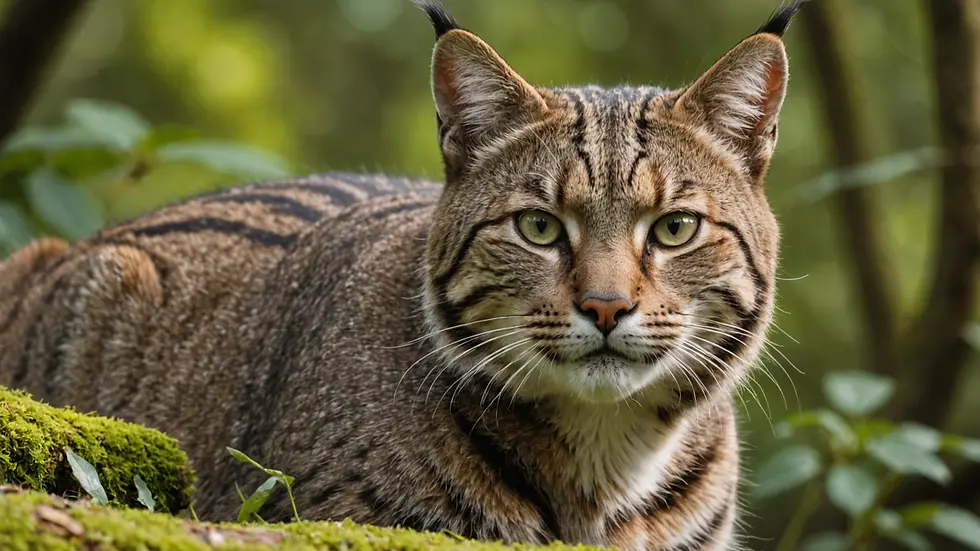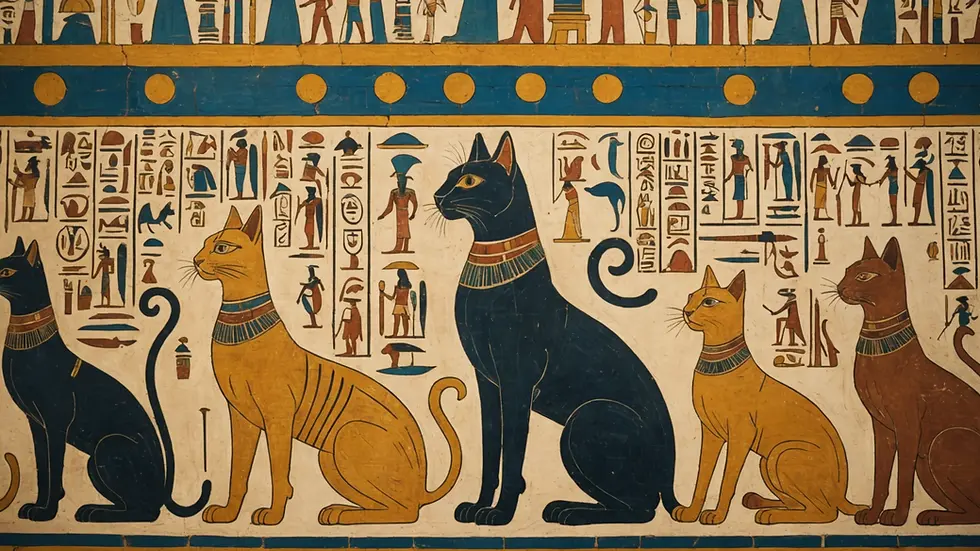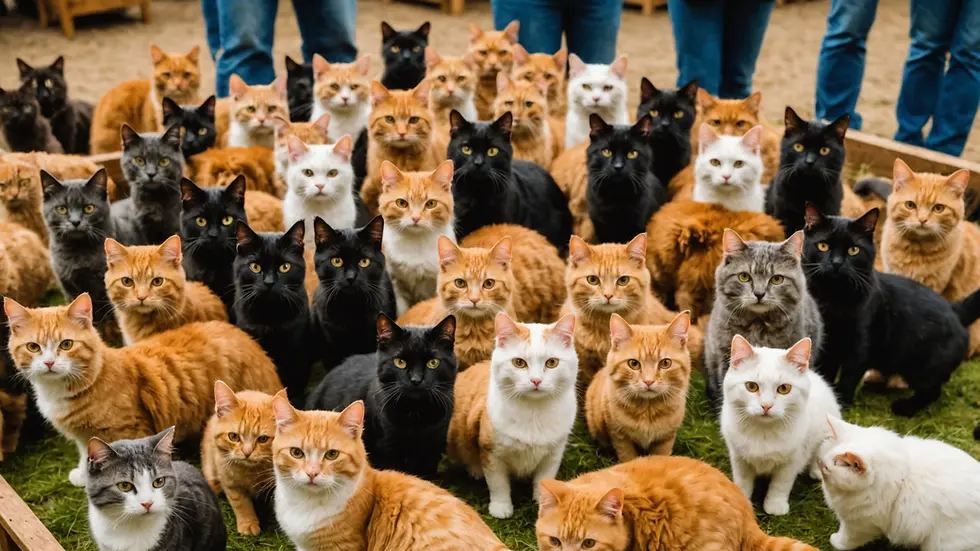Unraveling the Origins: The Enigmatic Tale of Cat Domestication
- Jyotiraj Borah
- Feb 5
- 5 min read
The journey of cat domestication is truly captivating. It's a tale that offers a glimpse into our evolving relationship with these enigmatic animals. From their wild beginnings to becoming beloved members of our homes, cats have fascinated people for thousands of years. This blog post explores the rich history of cat domestication, highlighting important studies and the significant impact felines have had on our lives.
The Wild Ancestors: Understanding Felis Silvestris
The story begins with Felis silvestris, the wild ancestor of today's domestic cat. These solitary hunters roamed Africa and Europe around 10,000 years ago.
These wildcats thrived in regions where agriculture was emerging, taking advantage of the rodents that flocked to human settlements. As people shifted from nomadic lifestyles to farming, wildcats found a reliable food source. This mutual benefit sparked a unique bond with humans, which grew stronger over time.
A close and intimate view of a wildcat in its natural habitat connects us to the history of our feline friends.

This fascinating interaction created a symbiotic relationship. Cats helped control the growing rodent population, and humans benefited from having their pests managed. As time passed, these wildcats became less fearful of humans, integrating into early communities.
The Early Evidence of Domestication
Cat domestication began around 7500 BCE, mainly in the Near East, especially Cyprus. Archaeologists discovered that cats were closely associated with humans in this period.
The burial site in Cyprus, dating back to 7500 BCE, revealed a grave containing both a human and a cat. This suggests that cats were more than just workers in the household; they held a special place in human lives.
Understanding an archaeological site evokes the ancient bond between humans and cats.

This evidence supports the idea that even in ancient times, cats were valued companions, not just creatures to keep pests at bay.
The Cats in Ancient Civilizations
As civilizations progressed, so did the perception of cats. In ancient Egypt, they were revered and seen as symbols of grace and protection. Known for their hunting skills, cats were linked to the goddess Bastet, who represented motherhood and fertility.
Cats featured prominently in Egyptian art, signifying their status in society. Many Egyptians believed harming a cat would bring bad luck, leading to legal protections for these revered animals.
As cats gained importance in Egypt, they spread across cultures. Trade routes allowed these feline companions to travel with sailors and merchants, expanding their influence to different parts of the world.
An artistic depiction of ancient Egyptian culture illuminating cats’ status can deepen our understanding.

The Spread of Cats across Europe and Asia
By the time of the Roman Empire, cats were well-established throughout Europe. Romans valued their pest control abilities, leading many to keep them as pets.
As Romans traveled, cats adapted to diverse environments and cultures. In China, they were prized for keeping rodent populations in check and became important in folklore and literature, solidifying their cultural significance.
However, negative superstitions also emerged, particularly during the Middle Ages in Europe. Cats were often linked to witchcraft, leading to campaigns against them that drastically reduced their populations.
The Duality of Perception
The complex relationship between humans and cats reflects a duality of perception. At times revered, and at others reviled, this perception has significantly influenced cats' social status throughout history.
The Renaissance and Return to Favor
With the Renaissance came renewed curiosity about the natural world and a resurgence in how cats were viewed. Artists and writers began to celebrate cats for their beauty, depicting them in countless works of art and literature.
Cats shifted from being simple hunters to cherished companions, earning a valued spot in European households. Their presence grew as exploration and colonization allowed them to accompany ships, further solidifying their role in societies across the globe.
The Advent of the Modern Cat
The 19th century marked a pivotal chapter in the story of domestic cats. Cat breeding became a recognized practice, leading to the emergence of various breeds that emphasized distinct traits and appearances.
The rise of cat shows highlighted breeds such as the Persian and Siamese. More than just working companions, cats were increasingly seen as beloved pets with unique identities.
Cat clubs emerged to promote specific breeds and maintain lineage standards. This breeding movement transformed how people viewed and valued cats, changing their roles in households worldwide.
A vintage cat show showcases how perceptions of cats have evolved in society.

Cats in Contemporary Society
Today, the bond between humans and cats has grown even stronger. Cats are now viewed as family members in many homes. Their independent yet affectionate nature makes them perfect companions for various lifestyles.
Cats have also become cultural icons, particularly with the rise of the internet. From memes to viral videos, they captivate millions and reflect a deeper bond with humans.
This digital age has fueled their popularity further, with many households embracing the joy that cats bring. Awareness of their intelligence and behavioral needs continues to grow, enhancing our understanding of these fascinating animals.
Understanding the Bond: Behavior and Communication
Improving the human-cat relationship requires understanding how domestication affects cat behavior. Cats communicate uniquely, using vocalizations and body language. Learning these signals helps create an environment that meets their needs.
For instance, a slow blink can signify affection, while an erect tail conveys happiness. Recognizing these cues fosters stronger bonds between humans and their feline friends.
Despite their domestication, cats retain many traits from their wild ancestors. Hunting instincts, grooming habits, and territorial behaviors reflect their primal roots. This blend of instincts and domestication serves as a testament to their evolving relationship with humans.
The Future of Cats and Humans
As we look ahead, the connection between cats and humans is set to grow. Pet ownership trends indicate an increasing appreciation for cats as companions, highlighting their welfare and living conditions.
Better veterinary care, nutrition, and behavioral insights promise healthier, happier cats. This ensures they will remain cherished members of our families.
Furthermore, feline-centered practices are gaining traction, emphasizing enriched environments for cats. Responsible pet ownership, including adoption and long-term commitment, promotes healthier relationships between humans and their feline companions.
The Journey of Cat Domestication
The history of cat domestication illustrates the intricate bond formed between humans and felines, evolving from wild creatures to beloved companions.
As we reflect on this remarkable journey, we recognize the pivotal role cats play in our lives. By fostering mutual respect and understanding, we can ensure this companionship endures for generations.
Ultimately, the tale of cat domestication is not just about the cats themselves but is woven into the broader story of humanity and continues to evolve today.




Comentarios